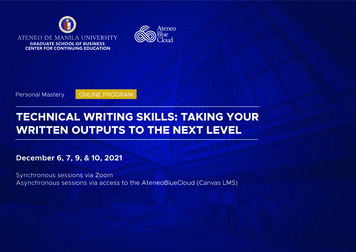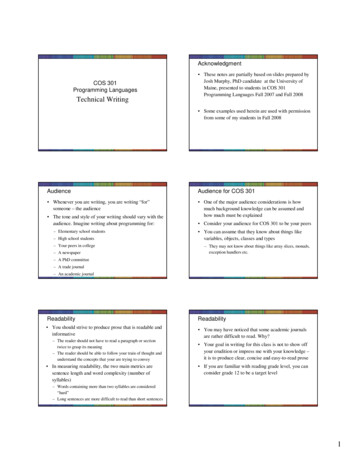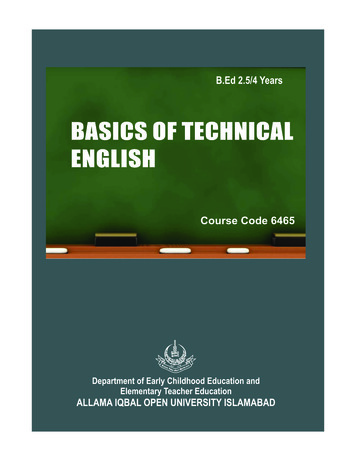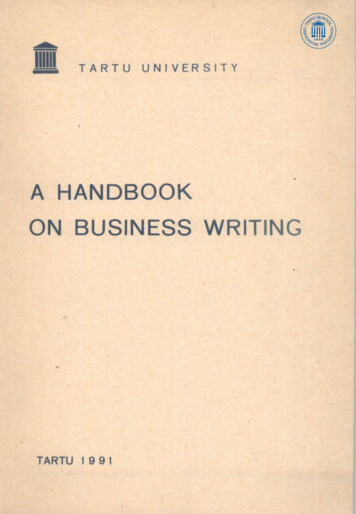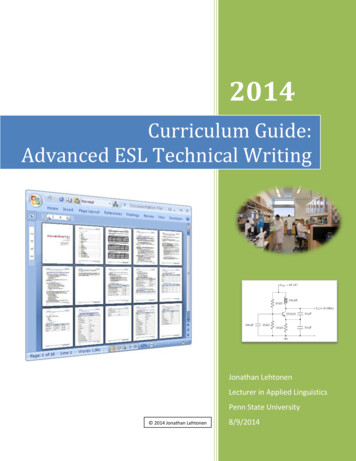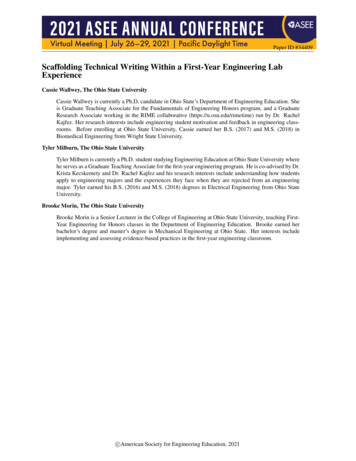
Transcription
Paper ID #34409Scaffolding Technical Writing Within a First-Year Engineering LabExperienceCassie Wallwey, The Ohio State UniversityCassie Wallwey is currently a Ph.D. candidate in Ohio State’s Department of Engineering Education. Sheis Graduate Teaching Associate for the Fundamentals of Engineering Honors program, and a GraduateResearch Associate working in the RIME collaborative (https://u.osu.edu/rimetime) run by Dr. RachelKajfez. Her research interests include engineering student motivation and feedback in engineering classrooms. Before enrolling at Ohio State University, Cassie earned her B.S. (2017) and M.S. (2018) inBiomedical Engineering from Wright State University.Tyler Milburn, The Ohio State UniversityTyler Milburn is currently a Ph.D. student studying Engineering Education at Ohio State University wherehe serves as a Graduate Teaching Associate for the first-year engineering program. He is co-advised by Dr.Krista Kecskemety and Dr. Rachel Kajfez and his research interests include understanding how studentsapply to engineering majors and the experiences they face when they are rejected from an engineeringmajor. Tyler earned his B.S. (2016) and M.S. (2018) degrees in Electrical Engineering from Ohio StateUniversity.Brooke Morin, The Ohio State UniversityBrooke Morin is a Senior Lecturer in the College of Engineering at Ohio State University, teaching FirstYear Engineering for Honors classes in the Department of Engineering Education. Brooke earned herbachelor’s degree and master’s degree in Mechanical Engineering at Ohio State. Her interests includeimplementing and assessing evidence-based practices in the first-year engineering classroom.c American Society for Engineering Education, 2021
Scaffolding Technical Writing within a First-Year Engineering LabExperienceIntroductionAlthough the education of engineers has been an ever-changing process that has developed overtime based on the needs of society [1], in more recent years the call for engineering educationreform has been stronger and echoed across multiple stakeholders. Government reports [2],industry leaders [3], [4], and scholars [5], [6] have all had a hand in bringing to light the changesthat need to take place in how we educate the future generation of engineers and how we shouldstudy and inform those changes. One of the more popular routes that colleges and universitieshave taken to improve their engineering education practices over the past two decades is theaddition of first-year engineering (FYE) programs.By 2013, almost 60% of engineering programs had implemented a first-year engineeringprogram [7]. The literature surrounding the purposes, practices used, and outcomes of these firstyear engineering program is extensive. Engineering Education conferences and journals havenumerous publications related to research on first-year engineering. Kajfez & MohammadiAragh [8] present a literature review of first-year engineering research in four major journals.This article found that research indicates FYE programs are an environment in which researchbased innovative classroom practices are commonly implemented in a way that enhances andimproves student learning. While FYE courses are most commonly used to introduce students toengineering principles and teach engineering students design skills, programming, andmathematics [9], this paper will focus on teaching technical writing as a part of a FYE programand how the techniques used to teach technical writing were developed and grounded inresearch-based practices.BackgroundTechnical Communication in EngineeringThe need for engineers to be proficient in the communication of technical content has beenreiterated many times over in publications and calls for action from engineering industry leaders(e.g. [10],[11]) and engineering educators (e.g. [12], [13]). In fact, technical communication hasbeen identified by many engineering and education professionals as a skill just as important asskills related to design [3], [14], and surveyed engineers have indicated that they spend asignificant amount of their working time communicating their work in a variety of ways [15].Although the results of a FYE program survey analyzed by Brannan & Wankat [9] noted thatcommunication skills were not a common area of weakness observed in incoming engineeringstudents compared to mathematics, science, or other general life skills, technical communicationhas been identified as a weakness of engineers leaving undergraduate programs and joining theworkforce [11]. The misalignment of skill deficits related to communication between whenstudents enter and leave engineering programs has led many engineering programs to take action.Many universities have introduced assignments and projects focused on technicalcommunication skills into courses across engineering curricula (e.g. [16], [17], [18]). Many FYEprograms have taken an active role in working to improve students’ technical communication -
and more specifically technical writing skills - through either specific courses or lessons (e.g.[19]) or by integrating technical writing into an already established course or project (e.g. [20]).Research-Based Teaching Practices1. ScaffoldingScaffolding as an educational tool is used to reduce the complexity of tasks and helpstudents focus their practice and build component skills [21], [22]. Scaffolding involves breakingdown large learning outcomes into smaller tasks that students complete in succession. Thesesmall tasks are meant to build and refine component skills necessary for the achievement of thelarge learning outcomes. Scaffolding has been shown to be successful in improving studentlearning at multiple education levels and across various subjects (e.g. [23], [24]). Additionally,scaffolding has recently proven to be a successful tool in improving student learning in writingenvironments [25]. Scaffolding also allows for additional opportunities for students to receivefeedback on their practice of component skills.2. FeedbackFeedback is an important learning tool that ranges from informal conversations withstudents about their work to their final course grade. In various contexts (e.g. education level,subjects), feedback has been shown to improve student learning by helping students improvetheir retention of the material, develop their content understanding, and interact moremeaningfully with their instructor [26]. By providing feedback to their students, instructors canstart a discussion about misconceptions or misunderstandings students hold. Students can correctany confusion they have using good feedback to direct their practice [22]. By using targetedfeedback, students can adjust and correct their misconceptions, recognize their strengths andweaknesses, and set learning goals [27]. Despite feedback being important to student learning,research has shown it can be underutilized by students [28]. Correction opportunities are anadditional learning tool used to encourage students to read and implement feedback provided tothem.3. Correction & Reflection OpportunitiesProviding students with opportunities to practice skills and apply knowledge are important stepsin helping students develop proficiency in a topic [22]. Dweck [29] also notes that learning fromfailure and using failure as an opportunity to identify shortcomings and improve is an importantquality of growth mindset. The benefits of having students make corrections on assessments –specifically test corrections - have been well-researched. Research on college physicsassessments found that not only did test corrections improve students’ learning, but they alsoreduced student stress [30]. Libertini, Krul, and Turner [31] describe their use of test correctionswith an additional reflection that has students provide details regarding their mistakes andcorrective actions. They note that this exercise not only improved student learning in a collegemathematics course but also helped students develop stronger study skills. This article alignswith additional research stating that the act of reflection on one’s own learning has also beenidentified as an important tool that improves retention of material [32].
Course ContextThe first-year engineering program at Ohio State, a large, midwestern, public university, isrequired for all incoming engineering students regardless of intended discipline. Each yearapproximately 2000 first-year students enroll in the program and take either the standard orhonors version of the two-course sequence. In this paper the authors will focus on the honorsversion of the program, which has an annual enrollment of around 300 students.Each class has approximately 36 students and a teaching team comprised of a faculty instructor,a graduate teaching associate, and undergraduate teaching assistants. The classrooms arearranged to encourage groupwork, with students seated at four-person tables with individualcomputers and a collaborative workspace [33]. These four-person groupings extend to thelaboratory experience, where students rotate groups approximately weekly. The facultyinstructors take primary responsibility for delivery of the classroom experience, while thegraduate teaching associates develop and lead the laboratory component under the guidance ofthe instructors.The first course in the honors sequence provides instruction in problem solving, computerprogramming, engineering design, and technical communication. The classroom portion of thecourse is presented studio-style in two-hour blocks three times a week. This coursework issupported by a weekly two-hour laboratory experience that includes an introduction to thevarious engineering disciplines available at the university, experimental design, data collectionand analysis, and technical communication. The course is taught using an inverted classroommodel [34] with both preparation and application assignments associated with each class and labday.In the laboratory component, these application (post-lab) assignments often take the form ofpartial or full laboratory reports. These reports have five primary sections: Introduction,Experimental Methodology, Results & Description, Discussion, and Summary & Conclusions.These five sections are often supplemented by one or more appendices. Students are providedwith a guide to lab reports and memos, formatting guidelines, and other supportingdocumentation. These full laboratory reports are used to assess students’ lab-related contentknowledge but also assess their technical writing skills such as content placement, tense, person,spelling, grammar, formatting, conciseness, and clarity of their writing.Though these laboratory experiences and their associated post-laboratory writing assignmentshave been effective at teaching students the intended technical content and laboratory reportwriting skills, they have often been identified as an area with opportunity for improvement.Students often report concerns regarding the workload associated with the laboratory componentof the course, including feelings of being “overwhelmed” by writing full laboratory reports [35].A New Assignment Structure: Scaffolding Post Lab AssignmentsIn summer 2020, instructional team members for ENGR 1281 proposed implementing new postlab assignments that utilized scaffolding as a tool facilitating student learning in technical writingfor Autumn 2020. This change was proposed following the decision for the delivery of ENGR1281 to be entirely virtual for the Autumn 2020 semester. Lab experiences that were typicallyhands-on were going to be re-imagined to achieve similar learning objectives through virtual
experiences. Instructional team members saw this need for immediate and large-scale change asan opportunity to integrate evidence-based education practices into the lab portion of the coursethat aimed to aid in students’ learning of technical writing practices. Table 1 compares Autumn2019’s lab schedule and associated technical writing post-lab assignments with Autumn 2020’slab schedule and associated technical writing post-lab assignments.Table 1: Autumn 2019’s lab & assignment schedule compared to Autumn 2020. Post-labs with technical writingfocus that are part of the complete quantitative analysis for this paper are denoted with blue text. Post-lab Full LabReports used for comparisons through t-tests are denoted with red **.WeekAutumn 2019Autumn 2020Lab NamePost-LabLab NamePost-Lab1Lab 1: MarbleCarrier2Lab 2: Spot SpeedStudy3456710111213Full Lab Report (individual)**Full Lab ReportRe-Write (individual) **Lab 1: Intro to LabWorksheetLab 2: Spot SpeedStudyExperimentalMethodologyLab 3: Circuits &ElectronicComponentsLab 4: P&G ProductLaunchLab 3: P&G ProductLaunchProfessional LetterLab 4: AnalogElectronicsWorksheetLab 5: ViscosityWorksheet & AbstractLab 5: ViscosityResults &DescriptionMemoLab 6: MaterialsTestingWorksheetFull Lab Report (individual)**Lab 7: Motors TestingDiscussionNo LabLab 8: HumanitarianReliefDiscussion &ConclusionsLab 6: MotorsTestingLab 7: DataAcquisition89WorksheetLab 8: Quality &ProductivityLab 9: MaterialsTestingLab 10: ToyAdaptationLab 11:Aerodynamics &PropulsionLab 12: StoplightFull Lab Report (group) **MemoWorksheetFull Lab Report (group)AbstractWorksheetProfessional EmailNo LabLab 9: Digital Signals& LogicLab 10: DataAcquisitionWorksheetFull Lab Report(partner) **No LabLab 11: AerodynamicsFull Lab Report(individual) **Scaffolding was integrated into the students’ laboratory experience through post-labassignments. For each post-lab used to scaffold technical writing practice and develop students’technical writing skills (Labs 2, 5, 7, and 8), only one or two section(s) of a lab report wasassigned. A new report section was introduced to students approximately every other week. Thepurpose of each section assigned was provided in each labs’ preparation documents.To provide students with continuity and multiple examples of the necessary content andinformation that belongs in each section of a lab report, all post-lab assignments were structured
using lab report headings (Introduction, Experimental Methodology, Results & Description,Discussion, and Summary & Conclusions). Questions related to the experimental methodologyused to collect data were asked under the “Experimental Methodology” heading. Similarly,questions asking students about the results of their data analysis would be found under the“Results” heading, and so on. When students were expected to write an entire section, that lab’spost-lab assignment would outline the purpose and necessary information for that section ratherthan listing individual question prompts. Appendix A provides the skeleton used to create eachpost-lab assignment.After scaffolding technical writing throughout the bulk of the semester, the last two labs (Lab 10and 11) asked students to write complete lab reports as their post-lab assignment, one as apartner lab report and the other as an individual lab report, as shown in Table 1.A New Feedback Structure: Post Lab Assignment Correct & ReturnAlong with proposing the scaffolded assignment structure to provide students with more lowerstakes practice with technical writing prior to being asked to write a full lab report, theinstructional team also wanted to provide students with opportunities and incentives toimplement feedback they may receive on scaffolded technical writing assignments. The proposedplan for offering opportunities to implement feedback was to offer optional correctionopportunities for students to earn points back that they missed on scaffolded technical writingportions of assignments.For each scaffolded technical writing section (Labs 2, 5, 7, & 8) and full lab report (Labs 10 &11), students could earn up to 5 points back on technical writing mistakes that resulted in pointdeductions by submitting a completed ‘Correct & Return’ worksheet. These worksheets askedstudents to include their original technical writing submission content, their corrected technicalwriting content, as well as a short reflection that addresses what mistakes were made, the stepstaken to correct those mistakes, and how those mistakes could be prevented in future technicalwriting submissions. This structure employs evidence-based principles related to the importanceof feedback to student learning [26] as well as the need for reflection upon one’s own learningfor improved retention of content [32].Students were given one week to asynchronously complete a lab’s procedures and post-labassignment. Grading of the post-lab assignment was completed by undergraduate teachingassistants (UTAs) within the next week. Students were given one week after grades and feedbackfor the post-lab were released to complete and submit the ‘Correct & Return’ worksheet. Thestructure of this feedback cycle informed the lab and scaffolding schedule shown in Table 1, asthe goal was to return feedback to students one week after the post-lab was submitted (two weeksafter the lab being assigned), which provided enough time for students to use feedback from theirmost recent technical writing submission to inform their writing for the next scaffolded technicalwriting assignment on the schedule.
LimitationsThe authors thought it particularly important to identify the limitations related to the conclusionsthat can be made from the data collected, analyzed, and presented throughout the remainder ofthe paper. The Autumn 2019 semester’s labs were structured and conducted as weekly hands-onlab experiences with mandatory attendance. Autumn 2020’s virtual lab experience had numerouschanges beyond the implementation of scaffolded technical writing assignments and correctionopportunities for those scaffolded assignments. Autumn 2020 labs were assigned asasynchronous experiences with optional attendance on the lab day to hear the lab content beelaborated on by Graduate Teaching Associates. All labs were conducted virtually with studentsrunning simulations or watching videos of the lab procedures being completed to collect data. Inthe case of some labs, lab content, timelines, and content-related expectations were adjusted orchanged between Autumn 2019 and Autumn 2020 to better fit the virtual environment.Controlling for all the changes necessary when adjusting first-year engineering lab experiencesfrom hands-on to virtual to confidently conclude that score changes were directly related to thenew scaffolded approach to technical writing would be nearly impossible.However, it’s also important to note that reports over the past year regarding how students’learning has been (and may be in the future) impacted by virtual learning amidst the COVID-19pandemic have pointed out that student learning experiences are likely being negatively impactedby the new virtual learning environment. Whether these impacts be emotional impacts due toisolation [38] or mental health struggles [39], or academic impacts due to higher workloads [40]and decreased motivation [41], college student learning is being negatively affected by theCOVID-19 pandemic and the abrupt transition to virtual learning. Although the data collectedand subsequent results related to the implementation of evidence-based practices in teachingtechnical writing cannot be evaluated independent of the impact of the pandemic, the fact that 1)students’ scores showed significant improvement and 2) many students self-reported positivelearning experiences despite the impact of the pandemic suggests anecdotal significance andpositive impacts related to the evidence-based approaches implemented in Autumn 2020.Data CollectionTo evaluate the effect of scaffolding on student performance, as well as effort, the grades andsurvey responses for the first-year honors engineering students in 2019 (N 392) and 2020 (N 287) were collected. The surveys, which asked for student feedback on the lab and the amount oftime the assignment took to complete, were conducted as part of regular instruction to monitorstudent attitudes and effort in order to direct and prioritize laboratory improvement efforts. Thesurvey was required and graded for completion after each post-lab submission. This paperfocuses on the question that asked, “How long did you spend on this post-experimentassignment?” Students self-reported the time, choosing from five ranges that togetherencompassed 0 minutes to 10 hours in 2019 and 30 minutes to 8 hours in 2020.The laboratory grades and survey responses were exported from the university’s Canvas-basedlearning management system into comma-separated value files and extracted using MATLAB. Agiven student’s grade data were matched with survey data using student ID and then the groupeddata were deidentified prior to analysis.
In addition to the quantitative data of student scores and survey responses, the program askedstudents to provide qualitative feedback in the form of an anonymous journal response [36]. Thisdata was collected from all sections of ENGR 1281 in 2020. The journal prompt evaluated in thisstudy read:“Now that ENGR 1281 labs are over for the semester, suggest one aspect of the LabReport writing assignments and/or lab experience that you found particularly beneficialand that you would keep the same. Constructively suggest one change or improvement tothe Lab Report writing assignments and experience.”The results were provided anonymously to the instructional team.Data AnalysisQuantitative Data AnalysisA custom MATLAB script extracted the scores on the assignments for both 2019 and 2020 data,as well as the scores on the Correct & Return submissions from the 2020 data. To betterunderstand student performance on the technical writing assignments, the scores were plottedusing histograms. To make comparisons between years and assignments more consistent, thehistogram bins were normalized by the percentage of responses they represented. These data setswere also plotted using box plots to show the spread of scores for each assignment and anyoutliers in the scores. T-tests were performed to test for an improvement in mean scores betweendifferent sets of assignments, including the first individual report, the final individual report, andthe first group report for each year.To better understand the time students spent on each technical writing assignment, counts fordifferent ranges of time were determined and plotted on bar plots. The 2019 surveys askedstudents to select how long they spent on each technical writing assignment, including potentialranges of 0-2 hours, 3-5 hours, 5-7 hours, 8-10 hours, or more than 10 hours. Because the surveywas setup where students could select multiple answers, any student that selected two answerswas sorted into the longer of the time ranges to account for a worst-case scenario. The number ofstudents who selected multiple answers accounted for less than 5% of the responses. To addressthe gaps in time and the potential for selecting multiple ranges, the 2020 surveys asked studentsto select a single value in the potential ranges of 0.5-2 hours, 2-4 hours, 4-6 hours, 6-8 hours, ormore than 8 hours. Because some students filled out a survey more than once, we took the largesttime range to account for the worse-case scenario again. The number of students who took thesurvey multiple times accounted for less than 2% of the total submissions for both years.Additionally, the total responses (normalized by the number of students) across all technicalwriting assignments were averaged for each year to give an estimate for the average time spentacross technical writing assignments in the course.Qualitative Data AnalysisQualitative data went through two rounds of coding. The first round of coding utilizedprovisional coding [37] in which predetermined codes were developed based on the topics of
interest and the prompt students were asked to answer that acted as the source of the qualitativedata. Considering the three evidence-based practices that were emphasized in this semester’spost-lab assignment structure were scaffolding, feedback, and correction opportunities, each ofthose served as a primary provisional code. These codes were assigned to passages of text ifwhat the student was describing related to the evidence-based practice, and therefore the studentdid not have to use the specific language or title of the evidence-based practice in order for thecode to be assigned. As an example, one participant mentioned that they “appreciated that we gotto focus on writing one section of the reports at a time and taking it week by week”. Althoughthey did not specifically identify this as the evidenced-based practice of scaffolding, it wastagged with the scaffolding code, as scaffolding was clearly the practice the student wasdescribing. Each of the codes had two secondary provisional codes: positive and negative. Thesesecondary codes were derived from the prompt students were given, to comment on onebeneficial aspect of the lab experience and one they would change. These secondary codes weresimplified as “positive” and “negative”. Continuing with the example provided above, thispassage would have been additionally tagged with the “positive” secondary code. This firstround of coding was quantized, and descriptive statistics of the quantized codes were used tocommunicate the presence and frequency that students specifically called out these evidencebased practices in open-ended questions regarding their Lab Report experiences.The second round of coding more closely examined the journal responses, and more specificallyeach of the passages previously tagged with one of the provisional codes. This round of codingfocused on theming the data within those responses related specifically to one of the provisionalcodes [37]. This form of analysis was used to allow for more detailed and descriptive results toemerge from the data that related to the students’ self-reported benefits of the evidence-basedpractices used.Results & DiscussionQuantitative Results & DiscussionRather than analyze the results of each technical writing assignment, we decided to compare theresults of specific cases between the two years. Specifically, this section analyzes the scores ofthe first individual report (including a rewrite opportunity in 2019), the final individual report,and the first group report for each year. Note that due to differences between the labs each year,the lab reports that are compared do not cover the same technical content, but have similarexpectations for the technical writing assignments. Additionally, this section analyzes the timestudents spent on the technical writing assignments.Scores on Lab ReportsFigure 1 shows the quantitative analysis of the first individual lab report students completed foreach year. Both the histograms and box plots show vastly different results between the two years,where students who practiced technical writing by scaffolding sections through the courseperformed much better than those students who wrote a report earlier in the semester withoutusing scaffolding to practice each section first. A one-tailed two-sample t-test was performed andconcluded that the students’ average score on the first individual report of 2020 was significantlyhigher than the average score on the first individual report of 2019.
Figure 1: Quantitative analysis of the first full individual lab report scores.While these results show a large difference in score between the two assignments, the 2020students were able to practice each section of a lab report at least once before writing a completelab report, while the 2019 students were asked to write a complete lab report without practicingeach section. The 2019 students received feedback on their Lab 2 report and had the opportunityto make corrections and resubmit their report. Figure 2 shows the comparison between the 2020Lab 11 report scores and the 2019 Lab 2 rewrite attempt. This comparison is representative ofscores after students had been given feedback and the opportunity to make corrections on eachlab report section. These results again show that that 2020 Lab 11 report scores weresignificantly higher than the 2019 Lab 2 rewrite scores.Figure 2: Quantitative analysis of the first full individual lab report scores (after a rewrite opportunity for the 2019students).To assess the students’ technical writing skills at the end of each semester, Figure 3 shows thecomparison between the last individual lab report of each year. As seen by the results, the 2020Lab 11 scores were significantly higher than the 2019 Lab 7 scores, providing evidence that the2020 students met the technical writing standards of the course better than the 2019 students. The2020 students received a 2% bonus on each technical writing assignment that was turned in atleast 24 hours early, but these grades were combined with their assignment scores, so it isdifficult to determine the actual scores of the 2020 Lab 11 report. However, when the t-test wasperformed again while reducing all 2020 Lab 11 report scores by 0.5% (equivalent to a quarter ofthe students submitting the assignment 24 hours early, a generous estimate based on anecdotalobservations), the t-test still provides significant results at an alpha value of 0.05.
Figure 3: Quantitative analysis of the last full individual lab report scores.To assess the students’ technical writing skills when working in a group, the first group labreport of each year was compared, seen in Figure 4. It may be important to note that the 2019students worked in groups of three or four, while the 2020 students worked in pairs. As seenfrom the figure, the 2020 Lab 10 scores and the 2019 Lab 8 scores did not vary significantly.These results suggest the 2020 students did not score significantly higher than the 2019 students,however the results also suggest that the 2020 did not score lower than the 2019 students despitewriting fewer reports over the semester.Figure 4: Quantitative analysis of the first full group
Scaffolding Technical Writing within a First-Year Engineering Lab Experience Introduction Although the education of engineers has been an ever-changing process that has developed over time based on the needs of society [1]

